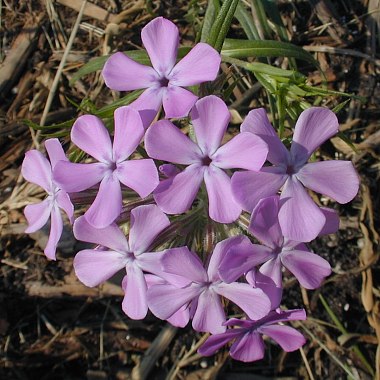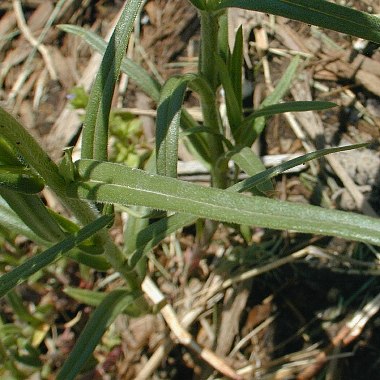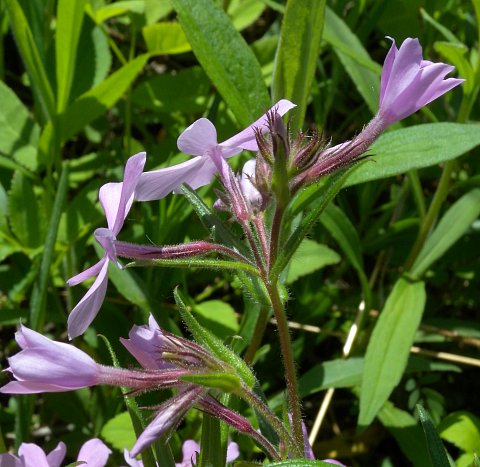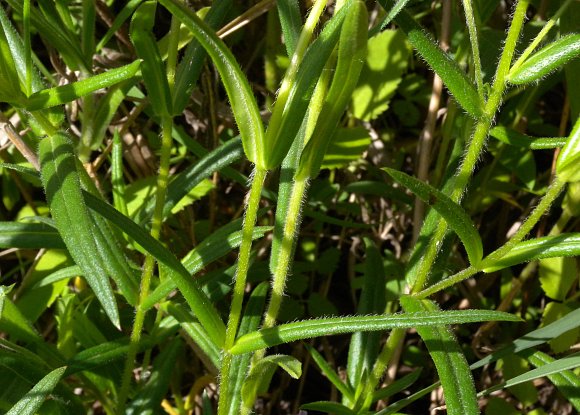Description: This herbaceous perennial plant is ½–1¾' tall and unbranched. The stem is terete, light green to purplish green, and it is covered with spreading white hairs. The opposite leaves are up to 3" long and 3/8" (7.5 mm.) across; they are sparsely to moderately distributed along the stem. The leaves are linear to linear-lanceolate, sessile, and mostly hairless, except along their margins and the lower side of their central veins. The lower leaves tend to turn yellow and drop off the stem when the plant becomes stressed out. There is a cluster of flowers at the apex of the plant on short hairy pedicels (floral stalks).

Each flower is about ½" across; its corolla has 5 widely spreading lobes at the apex of a narrowly tubular base. These lobes are obovate or oblanceolate in shape and often somewhat angular toward their tips. The calyx has a very short tubular base with 5 long narrowly linear teeth that extend along the narrowly tubular base of the corolla; this calyx is light green to deep reddish purple and hairy. The corollas of the flowers may be white, pink, or lavender; near the throat of the corolla, there are often markings that have a deeper color than the lobes. The flowers have a slight fragrance that is pleasant. Prairie Phlox typically blooms during late spring or early summer for about 3-4 weeks. This plant has a taproot, and it occasionally tillers at the base, sending up multiple stems from the same root system. The small seeds are distributed by the wind to some extent.

Cultivation:
The
preference is full or partial sun, and moist to mesic conditions. The
soil can consist of rich loam, clay loam, sandy loam, or have some
rocky material. Foliar disease doesn't bother this phlox to any
significant extent. It is difficult to start plants from seeds, but
somewhat easier from transplants. Sometimes, Prairie Phlox can be
temperamental and short-lived if a site doesn't suit its requirements.
Range & Habitat:
The native Prairie Phlox occurs occasionally in most of Illinois, but
is uncommon
or absent in west central and southeastern Illinois (see Distribution
Map). At high quality sites, it may be locally common.
Habitats include moist to mesic black soil prairies, rocky open
forests, Bur Oak savannas, sandy Black Oak savannas, limestone glades,
thickets, abandoned fields, and prairie remnants along railroads.
Prairie Phlox appears to benefit from the removal of excess debris by
wildfires occurring during early spring or the fall.

Faunal Associations: The nectar of the flowers attracts primarily long-tongued bees, butterflies, and skippers. Other visitors include moths and bee flies. Among the bee visitors are bumblebees, Anthophorine bees, little carpenter bees (Ceratina spp.), cuckoo bees (Nomada spp.), and green metallic bees (Agapostemon spp.). Butterfly and skipper visitors include the American Painted Lady, Sulfur butterflies, Swallowtail butterflies, and Cloudywing skippers. The caterpillars of a moth, Schinia indiana (Prairie Phlox Flower Moth), feeds on the flowers and developing seeds of Prairie Phlox.

Other moth caterpillars that feed on the flowers and
developing seeds of phloxes (Phlox spp.) include Heliothis turbatus (Spotted
Straw) and Heliothis phloxiphaga
(Dark-spotted Straw). Other insects feeding destructively on phlox
species include Lopidea davis (Phlox Plant
Bug), Poecilocapsus
lineatus
(Four-lined Plant
Bug), an aphid (Abstrusomyzus phloxae), and stem-boring larvae of a
long-horned beetle (Oberea flavipes). Mammalian herbivores readily
consume Prairie Phlox, including
rabbits, deer, groundhogs, and livestock. It may be difficult to
establish this plant where there is an overpopulation of these animals.
Photographic
Location:
The photographs were taken at the webmaster's wildflower garden in
Urbana, Illinois.

Comments: The flower structure of the Phlox genus is a classical example of a butterfly flower. Such flowers feature widely spreading petals or corolla lobes that function as a landing pad for these insects, and a long narrow corolla tube that is accessible to the long proboscis of butterflies, as well as skippers and moths. Such flowers typically occur in loose, rounded clusters, and they are often fragrant. The flowers of Prairie Phlox have all of these characteristics. A very rare variety of Prairie Phlox that occurs within the Sangamon river basin in Sangamon and Champaign counties is Phlox pilosa var. sangamonensis (Sangamon Phlox). This variety is distinguished primarily by its hairless stems, flowering stalks, and leaves, and it is listed as 'endangered' in the state of Illinois.